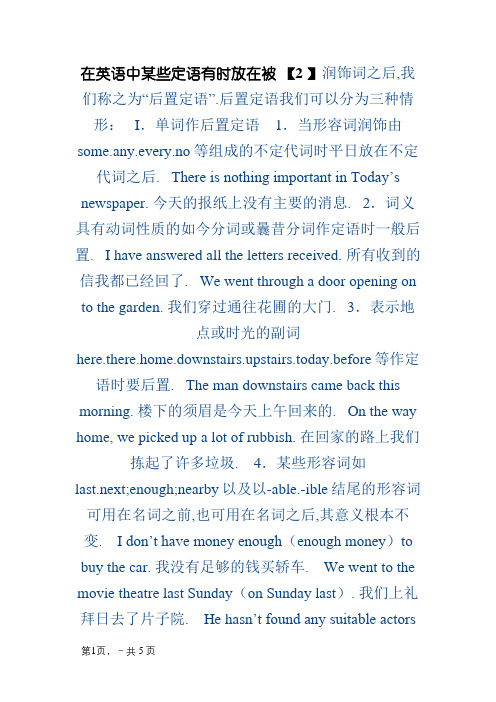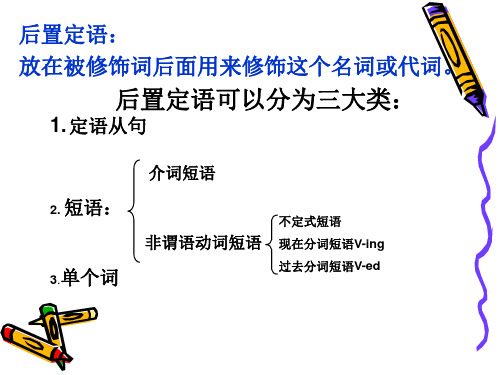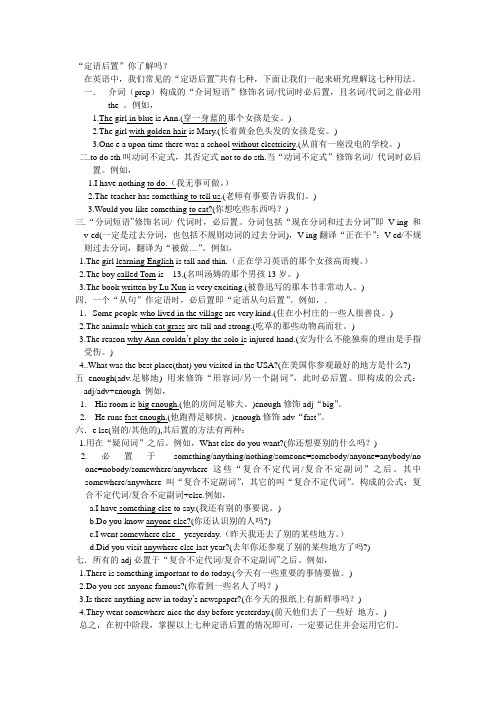英语后置定语的详细用法
英语 后置定语

英语后置定语在英语中,后置定语是修饰名词的语法结构,它们通常放在被修饰的名词之后。
后置定语可以是形容词、副词、介词短语、不定式短语、过去分词短语、现在分词短语或限定性从句。
以下是每种类型的后置定语的详细解释。
1. 形容词作后置定语形容词作后置定语时,一般放在被修饰的名词之后。
例如,“the boy beautiful”中,“beautiful”是形容词后置定语,修饰“boy”。
2. 副词作后置定语副词也可以作为后置定语,放在被修饰的名词之后,用来修饰或限定名词。
例如,“the car there”中,“there”是副词后置定语,修饰“car”。
3. 介词短语作后置定语介词短语通常用作后置定语,放在被修饰的名词之后,以表示与该名词相关的位置、时间、方式等。
例如,“the book on the table”中,“on the table”是介词短语后置定语,修饰“book”。
4. 不定式短语作后置定语不定式短语也可以用作后置定语,放在被修饰的名词之后,用来表示名词的动作或状态。
例如,“the decision to go”中,“to go”是不定式短语后置定语,修饰“decision”。
5. 过去分词短语作后置定语过去分词短语可以用作后置定语,放在被修饰的名词之后,表示被动关系或已经完成的状态。
例如,“the book written by him”中,“written by him”是过去分词短语后置定语,修饰“book”。
6. 现在分词短语作后置定语现在分词短语可以用作后置定语,放在被修饰的名词之后,表示主动关系或正在进行的状态。
例如,“the man talking to her”中,“talking to her”是现在分词短语后置定语,修饰“man”。
英语后置定语的详细用法

单个词做后置定语
02
Байду номын сангаас
(一)形容词做后置定语
2.英语中有些以a为词首的形容词做定语时,均放在被修饰语后面。如:alone, alike, afraid, , ashamed, awake 等 The girl asleep is my younger sister. He is the greatest writer alive.
我的句子:那个被Tom打的男孩是杨清。(beat)
named
written
3.动词不定式做后置定语: 与被修饰成分之间表示不同的语义关系: (1)表示动宾关系(2)表示主谓关系 (3)表示修饰关系 (4)表示同位关系
(1)表示动宾关系 被修饰的名词为动词不定式to do的直接宾语。 I have a lot of work to do today. He had a big family to support. I don’t have a house to live in . I don’t have a pen to write with. I don’t have a piece of paper to write on
He looked at the street full of cars(形容词短语)
我的句子:
副词做后置定语时一般表示时间、地点等. The weather here is very nice. The building around are modern .
(二)副词做后置定语
Is there anybody wounded? There is no money left . 我的句子:这儿的食物很美味。(副词) 我没有剩余的钱了。(过去分词)
后置定语的用法

在英语中某些定语有时放在被【2 】润饰词之后,我们称之为“后置定语”.后置定语我们可以分为三种情形: I.单词作后置定语 1.当形容词润饰由some.any.every.no等组成的不定代词时平日放在不定代词之后. There is nothing important in Today’s newspaper. 今天的报纸上没有主要的消息. 2.词义具有动词性质的如今分词或曩昔分词作定语时一般后置. I have answered all the letters received. 所有收到的信我都已经回了. We went through a door opening on to the garden. 我们穿过通往花圃的大门. 3.表示地点或时光的副词here.there.home.downstairs.upstairs.today.before等作定语时要后置. The man downstairs came back this morning. 楼下的须眉是今天上午回来的. On the way home, we picked up a lot of rubbish. 在回家的路上我们拣起了许多垃圾. 4.某些形容词如last.next;enough;nearby以及以-able.-ible结尾的形容词可用在名词之前,也可用在名词之后,其意义根本不变. I don’t have money enough(enough money)to buy the car. 我没有足够的钱买轿车. We went to the movie theatre last Sunday(on Sunday last). 我们上礼拜日去了片子院. He hasn’t found any suitable actors(actors suitable). 他还有找到适合的演员. 5.某些只能用作表语的形容词如afraid.alive.alone.asleep 等作定语时一般后置. He was the only man alive. 他是独一活下来的人. He spoke like a man afraid. 他讲起话来似乎是胆小之人. 6.某些形容词如present.elect.proper.interested.concerned.involved等可用在名词后,但与用在名词前意义不同.试比较:The present situation concerns all students present. 今朝的情形关系到在场的所有学生. Please fill in the blanks with the proper words. 请用适合的单词填空. The question proper has not been answered. 问题本身还没有得到答复. 7.基数词作定语,表示次序时,基数词一般后置.如: Les son One isn’t as interesting as Lesson Two. 第一课不如第二课有味. 8.表示近义或反义的两个形容词由and或or衔接作定语润饰统一个名词,用来进一步强调.说明时一般后置.如: He is a writer both witty and wise. 他是一位情趣横溢,愚蠢博学的作家. Countries, big or small, should be equal. 国度不管大小,应当一律平等. All the workers, old and young, attended the meeting. 不论老小,全部工人都参加了会议. II.短语作后置定语 1.形容词与表示器量的短语连用时一般后置. The river about twohundred miles long has all been polluted in my hometown. 在我故乡,那条大约二百英里长的河水已经全被污染. 2.形容词短语作定语时一般后置 a.形容词+副词 He worked in a factory far away.他在一个很远的工场工作. b.形容词+介词短语 He is a man greedy for money. 他是一个很贪钱的人. c.形容词+不定式 The boys easiest to teach were in my class. 那群最轻易教的男孩子们是我班的. d.形容词+连词+… They have a house larger than yours. 他们有一处比你们的大的房子. I haven’t seen flowers as beautiful as these. 我还没有见过跟这些一样美的花. 3. 介词短语作定语时放在它所润饰的名词之后.如: The lamp in the room gave poor light. 房子里的灯发出微弱的光. 4. 不定式短语作定语时一般后置.如: He has given us a lot of food to eat. 他已经给了我们许多的器械吃. 7.如今分词短语作定语时一般后置.如: The man riding a horse comes from the USA. 谁人骑马的汉子是美国人. 8.曩昔分词短语作定语时一般后置.如: Is English the language spoken by the largest number of people in the world. 英语是一门世界上说的人最多的说话吗? III.句子作后置定语当一个句子作定语润饰一个名词时平日放在所润饰的名词之后.这就是我们所说的定语从句.如:You mustn’t forget to have the fun that young people should have as they are growing. 你不应当忘却年青人成长时应当有的乐趣. Do you remember the man who served us at the restaurant that day? 你记得那天在饭铺里接待我们的那小我吗?留意:有时后置定语并不必定紧挨着它所润饰的名词,中央插入了一些词语.如: Ways are also found to make water clean. 让水干净的办法也已经找到. There are about eighty thousand different plants in the world that people can eat. 世界上大约有八万种不同的植物人们可以吃.。
英语后置定语的详细用法课件

1.现在分词短语作后置定语(表示主动意义) 1.There is a lady asking to see you. 2.The girl sitting by my side is my sister. 3.Here is a map showing you how to get to the station 4.They built a highway leading into the mountains. 5.We met a group of students returning from school.
我的句子:这儿的食物很美味。(副词)
我没有剩余的钱了。(过去分词)
后置定语: 放在被修饰词后面用来修饰这个名1. 定语从句
介词短语
2. 短语: 不定式短语
非谓语动词短语
3.单个词
现在分词短语V-ing 过去分词短语V-ed
介词短语做后置修饰语在意义上表示时间、地点、范围、类别、来源等语 义关系。
The weather in Beijing is colder than that in Guangzhou. People in the world play basketball. His love for his country is very great. The city of New York is very large.
named (name) Lucy. I know the girl _____ written (write) by MoYan is popular around the The book ______ world
我的句子:那个被Tom打的男孩是杨清。(beat)
后置定语的用法

在英语中某些定语有时放在被修饰词之后,我们称之为“后置定语”。
后置定语我们可以分为三种情况:I.单词作后置定语1.当形容词修饰由some、any、every、no等构成得不定代词时通常放在不定代词之后。
There is nothing important in Today’s newspaper、今天得报纸上没有重要得新闻。
2.词义具有动词性质得现在分词或过去分词作定语时一般后置。
I have answered all the letters received、所有收到得信我都已经回了。
We went through a door opening on to the garden、我们穿过通往花园得大门。
3.表示地点或时间得副词here、there、home、downstairs、upstairs、today、before等作定语时要后置。
The man downstairs came back this morning、楼下得男子就是今天上午回来得。
On the way home, we picked up a lot of rubbish、在回家得路上我们拣起了很多垃圾。
4.某些形容词如last、next;enough;nearby以及以-able、-ible结尾得形容词可用在名词之前,也可用在名词之后,其意义基本不变。
I don’t have money enough(enough money)to buy the car、我没有足够得钱买轿车。
We went to the movie theatre last Sunday(on Sunday last)、我们上星期日去了电影院。
He hasn’t found any suitable actors(actors suitable)、她还有找到合适得演员。
5.某些只能用作表语得形容词如afraid、alive、alone、asleep等作定语时一般后置。
定语后置

“定语后置”你了解吗?在英语中,我们常见的“定语后置”共有七种,下面让我们一起来研究理解这七种用法。
一.介词(prep)构成的“介词短语”修饰名词/代词时必后置,且名词/代词之前必用the 。
例如,1.The girl in blue is Ann.(穿一身蓝的那个女孩是安。
)2.The girl with golden hair is Mary.(长着黄金色头发的女孩是安。
)3.Onc e a upon time there was a school without electricity.(从前有一座没电的学校。
)二.to do sth叫动词不定式,其否定式not to do sth.当“动词不定式”修饰名词/ 代词时必后置。
例如,1.I have nothing to do.(我无事可做。
)2.The teacher has something to tell us.(老师有事要告诉我们。
)3.Would you like something to eat?(你想吃些东西吗?)三.“分词短语”修饰名词/ 代词时,必后置。
分词包括“现在分词和过去分词”即V-ing和v-ed(一定是过去分词,也包括不规则动词的过去分词),V-ing翻译“正在干”;V-ed/不规则过去分词,翻译为“被做…”。
例如,1.The girl learning English is tall and thin.(正在学习英语的那个女孩高而瘦。
)2.The boy called Tom is 13.(名叫汤姆的那个男孩13岁。
)3.The book written by Lu Xun is very exciting.(被鲁迅写的那本书非常动人。
)四.一个“从句”作定语时,必后置即“定语从句后置”。
例如,.1.Some people who lived in the village are very kind.(住在小村庄的一些人很善良。
英语的定语后置

定语后置【2 】1. 某些表示地点.方位.时光的副词作定语时,平日要后置.例如:Do you know the lady downstairs ?你熟悉楼下的那位密斯吗?The people there are going to Beijing.那边的人们打算去北京.The life tomorrow will be more comfortable.明天的生涯将令人觉得更舒适.2. 介词短语作定语时,必须后置.例如:The friendship between the two countries will last forever . 两国之间的友情将长存. The ball under the chair is mine.椅子下的球是我的.3. 非谓语动词短语(不定式和分词)作定语时,必须后置.例如:The people living here are fond of folk songs.住在这里的人们爱好平易近歌.What is the language spoken in this African country ? 这个非洲国度讲什么说话? This is the gentleman to be interviewed next time.这是下次要采访的师长教师.4. 从句作定语时,必须后置.例如:She married a man who is rich.她嫁给了一位有钱人.The officer visited an island where only two soldiers live .这位军官拜访了只有两位兵士栖身的一个岛屿.5. 其他定语后置现象(1)形容词润饰不定代词时,平日要后置.例如:-What’s the matter with you ? 您怎么啦?-Nothing serious. 没啥大不了的事儿.There’s something wrong with the machine.这机械有缺点.(2)形容词短语作定语时,平日后置.例如:Italian is a Language very difficult to learn.意大利语是一门异常难学的说话.She has a garden much larger than yours .她的花圃比你的花圃大得多.(3)含有-able , -ible 等后缀的形容词作定语时,常放在被润饰的词后面.例如: The travellers have tried all the ways possible.这些观光者已试过了所有可能通的路.I have a computer available.我有一台可应用的电脑.(4)某些形容词如alive .asleep等作定语时,必须后置.例如:The lady is one of the greatest novelist alive.这位密斯是当今最巨大的小说家之一.The man asleep in bed is my elder brother .熟睡在床上的人是我哥哥.注:某些形容词前置与后置时,意义有很大的差别.例如:The present government supports the USA.如今的当局支撑美国.The Smiths , and other people present were surprised at the news .史密斯伉俪以及其他在场的人对此新闻觉得惊奇.That’s not the proper way to stop the machine. 用这种方法关失落机械是不妥善的.Architecture(建筑)proper is art .建筑本身就是艺术.。
英语后置定语的用法总结

英语后置定语的用法总结英语后置定语的用法总结如下:1. 形容词作后置定语:单个的形容词作定语,通常放在它所修饰的名词之后。
例如:The climate here is very pleasant.这里的气候十分宜人。
2. 介词短语作后置定语:介词短语作定语时,介词短语的位置也在名词之后。
例如:This is a book of his. 这是他的书。
3. 动词不定式作后置定语:动词不定式作定语的情况不多,多位于被修饰词的后面。
例如:The first textbook to come out in the wake of the new reform is English. 新改革后出版的第一部教科书是英语课本。
4. 副词作后置定语:副词作定语时,一般置于它所修饰的名词之后。
例如:In the world, family is the only place where we can find love, warmth and comfort. 在这个世界上,家是我们唯一能够找到爱、温暖和舒适的地方。
5. 从句作后置定语:从句作定语时,一般置于它所修饰的名词之后。
例如:He found a watch which had belonged to his grandfather in a drawer.他在抽屉里发现了他祖父的一块手表。
6. 名词作后置定语:名词作定语时,通常放在它所修饰的名词之后。
例如:The book of the day is “Alice in Wonderland”. 今天的推荐读物是《爱丽丝漫游奇境记》。
7. 形容词短语作后置定语:形容词短语作定语时,通常放在它所修饰的名词之后。
例如:The little boy, up to his elbows in flour, was baking a cake. 那个小男孩,手肘上沾满了面粉,正在烤蛋糕。
8. 名词短语作后置定语:名词短语作定语时,通常放在它所修饰的名词之后。
动词不定式作后置定语的用法总结

动词不定式作后置定语的用法总结一、不定式作后置定语的基本结构1. 不定式作后置定语时,通常紧跟在被修饰的名词或代词后面,构成主谓宾结构。
例如:我有很多事情要做。
2. 不定式可以由"to"加动词原形构成,也可以省略"to"。
例如:I have some work to do. 或 I have some work that needs doing.3. 不定式一般不受主语的人称和数的限制。
例如:We have something to discuss. 或 They have a problem to solve.二、不定式作后置定语的句型分析1. 主动不定式:表示被修饰的名词或代词的动作是由它所指代的人或物发出的。
例如:She is a girl to admire.(她是一个值得钦佩的女孩。
)2. 被动不定式:表示被修饰的名词或代词本身所承受的动作。
例如:There are many problems to be solved.(有许多问题待解决。
)3. 完成式不定式:表达在不定式动作发生之前已经发生的动作。
例如:He has a lot of work to have done.(他有很多工作是已经做完的。
)三、不定式作后置定语的语法功能1. 修饰名词或代词,充当后置定语,进一步说明其性质、特征或属性。
2. 说明被修饰名词或代词的用途、目的、原因或结果。
3. 表示被修饰名词或代词的动作或状态。
四、不定式作后置定语的一些注意事项1. 不定式作后置定语时,一般需放在被修饰名词或代词的后面,形成定语从句。
2. 不定式作后置定语要和被修饰的名词或代词保持一致,包括数、人称和性质。
3. 不定式作后置定语要注意使用时态的变化,通常受上下文的语境所限制。
结语动词不定式作后置定语在英语中是一个非常常见的句式结构,它丰富了句子的表达方式,使句子更具表现力和丰富度。
了解和掌握不定式作后置定语的用法,对于提高英语写作能力和阅读理解能力都有着非常重要的意义。
后置定语的用法总结

后置定语的用法总结后置定语是一种修饰短语、词或句子的语法结构,通常位于被修饰语之后,用来详细描述、限定或补充被修饰语的内容。
这种修饰结构在英语中较为常见,用途广泛,使得表达更加准确、丰富。
一、后置定语的基本结构与位置:后置定语包括介词短语、分词短语、从句、不定式短语等等。
它们可以修饰名词、代词、动词、形容词或其他副词短语。
后置定语通常位于被修饰语之后,用逗号或连字符隔开,以区别于前置定语。
1. 后置定语修饰名词:The man in the black coat is my father.穿着黑色外套的那个人是我父亲。
2. 后置定语修饰代词:The book I borrowed from the library is very interesting.我从图书馆借来的那本书非常有趣。
3. 后置定语修饰动词:He came in followed by his dog.他进来了,后面跟着他的狗。
4. 后置定语修饰形容词:She is happy, surrounded by her friends.她被朋友们包围着,感到很开心。
5. 后置定语修饰副词短语:He ran up the hill, out of breath.他气喘吁吁地跑上了山。
二、后置定语的功能:后置定语可以提供更多的信息,对被修饰语进行补充、说明或限定,丰富了句子的含义和表达的层次。
下面是后置定语常见的功能和作用:1. 补充说明:通过后置定语可以添加额外的描述信息,使句子更加详尽、具体。
The students, excited about the upcoming trip, couldn't wait to board the bus.这些学生对即将到来的旅行感到兴奋,迫不及待地想上车。
2. 限定范围:后置定语可以起到限定作用,缩小被修饰语的范围。
The streets in the city center are always busy.市中心的街道总是很繁忙。
ing作后置定语的用法

ing作后置定语的用法英语中,作后置定语的ing形式可用来修饰名词或代词,表达被修饰名词或代词所进行的动作或状态。
这种用法通常用于非限定性定语从句或形容词短语中,为句子增加了更多的信息。
本文将详细介绍ing 作后置定语的用法及相关注意事项。
一、ing作后置定语修饰名词或代词Ing作后置定语修饰名词或代词时,常用于非限定性定语从句中,为句子增加额外的信息。
下面是一些例子:1. The girl, crying bitterly, was consoled by her friend.这个女孩哭得很伤心,她的朋友安慰她。
2. I found the book, written by my favorite author, very interesting.我发现这本书,是我最喜欢的作者写的,非常有趣。
在以上例子中,ing形式的动词短语"crying bitterly"和"written by my favorite author"分别修饰名词"girl"和"book",起到进一步描述的作用。
二、ing作后置定语修饰句子Ing作后置定语还可用于修饰整个句子,起到形容词短语的作用。
以下是一些例子:1. She sat in the corner, thinking about her future.她坐在角落里,思考着她的未来。
2. He stood there, watching the sunset.他站在那里,看着夕阳。
在以上例子中,ing形式的动词短语"thinking about her future"和"watching the sunset"分别修饰整个句子,描述动作或状态。
三、注意事项1. Ing作后置定语的动词短语通常与被修饰的名词或代词之间存在逻辑上的主谓关系。
例如,在第一个例子中,"crying bitterly"是由名词"girl"引起的,表达了女孩伤心哭泣的状态。
英语后置定语的详细用法课件

• 注意: • 动词不定式有时可以代替一个定语从句做后置定语。 • (一般指将来的,还未做的事情) • 例如
• (1)Perhaps in the years to come(=that will come) we will meet again.(同:U4课文最后一句)
• 也许在未来的岁月中我们还会再见面。
The building around are mostly of modern constructions. 这附近多数是现代化建筑。
主
谓
• (3)表示修饰关系 动词不定式对其修饰的成分起一种描绘阐述作用。
• 例如: It’s already time to start planting trees.
• 已经到了植树的季节。
• He had no chance to go school in those years.
• 那时候,他没有机会上学。
(4) 表示同位关系 不定式和被修饰的名词处于平行关系 只对其起一种解说作用。 例如:
Soon came the order to start the general attack. 很快下达了发起总攻的命令。
We got no instructions to leave the city. 我们没有接到离开这座城市的指示。
• 现在分词短语做后置定语,在意义上相当于一 个定语从句。(常表进行、主动关系)
• 但在转换时,要注意动词的主语和时态。
• They built a highway leading into the mountains. • We met a group of pupils returning from school. • 例如上述两句可转化为:
英语中的后置定语

英语中的后置定语在英语中,如果定语是由一个单词表示时,通常要前置。
而由一个词组或一个句子表示时,通常则后置。
而以下情况是由单个单词作定语并后置的几种现象。
一、形容词enough作定语,而着重点又是强调它所修饰的那个名词,或者它所修饰的名词起形容词作用且前面不加冠词时,通常要后置。
例如:I haven't time enough to do the work.我没有足够的时间做那件工作。
He hasn't man enough to admit his mistake.他没有勇于认错的大丈夫气概。
二、当定语是一个形容词,它所修饰的是由any-,every-, some-等跟-body, -one,-thing构成的复合代词时,通常后置。
例如:There is something important in today's newspaper.今天的报纸上有条重要新闻。
He wanted to get someone reliable to help in this work.他想找个可靠的人帮忙做这项工作。
三、它所修饰的词前面有用以加强语气的the one等之类的词语时须后置。
定语由形容词表示,它所修饰的词是起名词作用的anywhere, somewhere等时,也须后置。
例如:This is the one thing needful.这是唯一需要的东西。
Can you find anywhere quiet?你能找个清静的地方吗?He has been sent to somewhere particular.他被派到某个特定的地方去了。
四、定语由here, there, in, out, home, above, below, abroad, before, yesterday等副词充当时,往往要后置。
例如:He is on his way home.他在回家途中。
Can you tell me something about the social system there?你能给我讲讲那里的社会制度吗?It had been fine the day before.前一天的天气很好。
后置定语的用法

在英语中某些定语有时放在被修饰词之后,我们称之为“后置定语”。
后置定语我们可以分为三种情况:I.单词作后置定语1.当形容词修饰由some、any、every、no等构成的不定代词时通常放在不定代词之后。
There is nothing important in Today’s newspaper. 今天的报纸上没有重要的新闻。
2.词义具有动词性质的现在分词或过去分词作定语时一般后置。
I have answered all the letters received. 所有收到的信我都已经回了。
We went through a door opening on to the garden. 我们穿过通往花园的大门。
3.表示地点或时间的副词here、there、home、downstairs、upstairs、today、before等作定语时要后置。
The man downstairs came back this morning. 楼下的男子是今天上午回来的。
On the way home, we picked up a lot of rubbish. 在回家的路上我们拣起了很多垃圾。
4.某些形容词如last、next;enough;nearby以及以-able、-ible结尾的形容词可用在名词之前,也可用在名词之后,其意义基本不变。
I don’t have money enough(enough money)to buy the car. 我没有足够的钱买轿车。
We went to the movie theatre last Sunday(on Sunday last). 我们上星期日去了电影院。
He hasn’t found any suitable actors(actors suitable). 他还有找到合适的演员。
5.某些只能用作表语的形容词如afraid、alive、alone、asleep等作定语时一般后置。
英语语法之英语中的后置定语5种情况

英语的后置定语英语中有些情况是把修饰名词的定语放在后面,构成A+B结构,但是我们在翻译理解成中文时要调过来成B+A结构,接下来我们就来看看有哪些定语后置的情况:一.形容词短语做后置定语:例句:1.The parts of a museum open to the public are called galleries or rooms. (2020新高考一卷语法填空)2.I need to buy some things necessary in university.二.非谓语动词:1.Do you know the girl playing the piano over there?2.The data collected from the device is very useful.3.You don’t have much time to waste.三.介词短语:1.In recent decades, laws against unfair rules for voting have been passed.2.He is a man of principle.四.定语从句:1.You need a great teacher who lets you make mistakes.2.In the mid-1700s, England began passing laws that made the American colonies angry.五.个别特殊单个词:1.Americans today今天的美国人2.people nowadays现在的人们3.the introduction below 下面的介绍4.the description above上面的描述5.the news abroad 国外的新闻6.people present/concerned/involved。
英语后置定语和后置分词作状语

英语后置定语和后置分词作状语
英语中的后置定语是指修饰名词的定语放在名词的后面的结构。
这种结构在英语中相对较少见,但在一些情况下会用到。
例如,在
表示时间的名词后面放置的定语,比如"the year 2020"中的"2020"
就是一个后置定语。
另外,在一些习惯用法中,形容词和介词短语
也可以放在名词后面作为后置定语,比如"the person concerned"
中的"concerned"就是一个后置定语。
后置分词作状语是指动词的过去分词或现在分词放在句子中作
状语,通常用来表示伴随、原因、条件、时间、方式等。
这种结构
在英语中非常常见。
例如,在句子"Feeling tired, she decided
to take a nap."中,"Feeling tired"就是一个后置分词作状语,
表示伴随的动作。
另外,在句子"Having finished her work, she went home."中,"Having finished her work"是一个后置分词作状语,表示在完成工作之后发生的动作。
总的来说,后置定语和后置分词作状语都是英语中较为常见的
句法结构,它们丰富了句子的表达方式,使语言更加生动多样。
在
写作和交流中,合理运用这些结构可以使语言表达更加准确和丰富。
- 1、下载文档前请自行甄别文档内容的完整性,平台不提供额外的编辑、内容补充、找答案等附加服务。
- 2、"仅部分预览"的文档,不可在线预览部分如存在完整性等问题,可反馈申请退款(可完整预览的文档不适用该条件!)。
- 3、如文档侵犯您的权益,请联系客服反馈,我们会尽快为您处理(人工客服工作时间:9:00-18:30)。
3、现在分词短语做后置定语 现在分词短语做定语时,一定放在被修饰成分 的后面。 例如:
They built a highway leading into the mountains. 他们修建了一条通往山里的公路。
We met a group of pupils returning from school. 我们碰到了一群从学校回来的孩子。
• 注意: • 动词不定式有时可以代替一个定语从句做后置定语。 • (一般指将来的,还未做的事情) • 例如
• (1)Perhaps in the years to come(=that will come) we will meet again.(同:课文最后一句)
• 也许在未来的岁月中我们还会再见面。
Is there anything planned for tonight? 今晚有什么活动吗?
5、动词不定式做后置定语:
与被修饰成分之间表示不同的语义关系:
(1)表示动宾关系 (2)表示主谓关系 (3)表示修饰关系 (4) 表示同位关系
• (1)表示动宾关系
• 例如:
宾
动
• I have a lot of work to do today.
• 现在分词短语做后置定语,在意义上相当于一 个定语从句。(常表进行、主动关系)
• 但在转换时,要注意动词的主语和时态。
• They built a highway leading into the mountains. • We met a group of pupils returning from school. • 例如上述两句可转化为:
出席会议的领导共有八人。
This is a subject worthy of careful study.
这是一个值得仔细研究的问题
三.单个词做后置定语
• (一)某些形容词 • (二)副词 • (三)某些过去分词
(一)形容词做后置定语
• 1.以a为词首的形容词 • 2.以后缀-able 和-ible 结尾的形容词 • 3.形容词修饰 由any-,every-, some-等跟-
• They built a highway which led into the • mountains. • We met a group of pupils who returned • from school.
4、过去分词短语做后置定语 表示被动意义、完成意义或状态意义。
例如: What’s the language spoken in that area? 那个地区讲什么语言?
angry.
二.短语做后置定语
• 1、介词短语 • 2、形容词短语 • 3 、现在分词短语 • 4、过去分词短语 非谓语动词 • 5、动词不定式 • 6、有些形容词常与某些介词短语搭配
1、介词短语做后置定语 介词短语做后置修饰语,在意义上表示时间、地点、 范围、类别、来源、等语义关系。 例如:
The weather in Beijing is colder than that in Guangzhou. (地点)北京的天气比广州冷。
• 1) Is there anybody injured?有人负伤吗? • 2) The money left is not enough for so many
people to live through. • 剩余的钱不够这么多人用的。 • 3) She liked all the courses offered. • 她对所开的课程都很喜欢。 • 4) The experience gained will be of great
(4) 表示同位关系 不定式和被修饰的名词处于平行关系 只对其起一种解说作用。 例如:
Soon came the order to start the general attack. 很快下达了发起总攻的命令。
We got no instructions to leave the city. 我们没有接到离开这座城市的指示。
It's the only solution possible. 这是唯一可能采取的解决办法。 Are there any tickets available?还有票吗? That's the only star visible now.那是颗现在唯一可见 的星。
3.形容词修饰 由any-,every-, some-等跟-body, -one, -thing构成的 不定代词时,一般放在其后。
• (2)She made a list of things to be taken(=
• which/that will be taken
) on the way.
• 她开了一张要带在路上用的物品清单。
6、有些形容词常与某些介词短语搭配,作 后置定语
The leaders present at the meeting totaled eight.
• 总结后置定语的用法?哪类句子,短语,词可以 做后置定语?
后置定语可以分为三大类:
1. 定语从句
非谓语动词短语
2. 短语:
形容词短语
不定式短语 现在分词短语 过去分词短语
介词短语
某些形容词 3.单个词 副词
某些过去分词
一.定语从句做后置定语 用法: 1.构成:先行词+关系代/副词+从句 2. 引导定语从句的关联词包括关系代词和关系副词。 关系代词:that, which, whose, who, whom, as; 关系副词:when, where, why。
Translate this sentence into Chinese:
The student who answered the question was John.
The boy (whom) you are talking to is my brother.
People who take physical exercise live longer. I still remember the day when /on which my
• He is the greatest writer alive.
• 他是当代最伟大的作家。
2.以后缀-able 和-ible 结尾的形容词,也可后置。 例如: He is the only person reliable. 他是唯一可信赖的人。
I know the actor suitable for the part. 我认识适合扮演这个角色的演员。
value to us. • 取得的经验将我们很有价值。
brother joined the army. I still remember the days which/that we spent
together. I‘d like a room whose window looks out over the
sea. He changed his mind, which made me very
英语定语后置的详细用法
• 后置定语: • 放在被修饰词后面 • 用来修饰这个名词或代词的。
• The student who answered the question was John. • The weather in Beijing is colder than that in
Guangzhou. • He looked at the street full of cars. • They built a highway leading into the mountains. • What’s the language spoken in that area? • He had no chance to go school in those years. • The girl asleep soundly is my younger sister. • The weather here is very nice. • The experience gained will be of great value to us.
The building around are mostly of modern constructions. 这附近多数是现代化建筑。
(三)部分过去分词也可以作后置定语 • 例如: • left, used, offered, discussed, ordered,
injured, concerned, held, arranged, planned, suggested, finished, completed, given, 等。
2.形容词短语做修饰语时,往往后置。 例如:
He looked at the street full of cars. 他看着车辆拥挤的街道
Italian is a Language very difficult to learn. 意大利语是一门非常难学的语言。
She has a garden much larger than yours . 她的花园比你的花园大得多。
• 我今天有很多活要干
• He had a big family to support.
• 他有一个大家庭需要他来养活。
(2)表示主谓关系 被修饰的名词表示逻辑主语 修饰它的动词不定式结构表示逻辑谓语。 例如:
He’s always the first to come. 他总是第一个来。
Among the men to take part in the work, he is probably the most active. 在要参加这项工作的人中,他恐怕是最积极的。
主
谓
• (3)表示修饰关系 动词不定式对其修饰的成分起一种描绘阐述作用。
